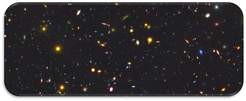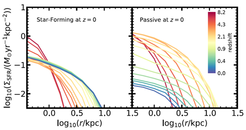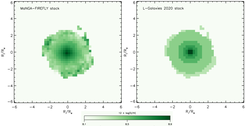L-GALAXIES 2020: Modelling millions of galaxies across billions of years

Fig. 1: A portion of deep space from the L-Galaxies computational model. This image was made using the MRObs virtual observatory, which selects galaxies of known position, mass, age, size, etc., from the model, assigns them random inclinations, and computes their observed colour as it would be seen by the Hubble Space Telescope.
The key power of L-GALAXIES is it's efficiency. The model runs tens of thousands of times more quickly than the latest hydrodynamical simulations, even though its size is hundreds of times larger. This comes with limitations in the way the dynamics and morphologies of galaxies can be modelled, but allows scientists to precisely pin-down the true impact and efficiency of the key astrophysical processes such as gas cooling, star formation, and supernova & black hole feedback, by using sophisticated statistical techniques to constrain their key parameters.
L-GALAXIES 2020 is the first model of its kind to simultaneously incorporate physical prescriptions for molecular hydrogen formation, chemical element production, and the flow of material within radially resolved galaxies. These enhancements have added a completely new dimension to studies that can be carried-out. For example, scientists can now use L-GALAXIES 2020 to interpret data on the internal distribution of gas and stars within real galaxies provided by integral field units (IFUs) mounted on powerful ground-based telescopes.
The ability to resolve galaxies spatially is critical for modelling the transition from atomic to molecular gas in galaxies. Molecular gas formation is believed to depend on gas density, occurring predominantly in the densest regions near the centres of galaxies. In order to follow the formation of molecular hydrogen correctly, it is therefore necessary to accurately track the surface density of cold gas.
So what has L-GALAXIES 2020 revealed?

Fig. 2: The two plots show the star-formation-rate density with respect to the distance from a galaxy centre for star-forming galaxies similar to our Milky Way (left panel) and more massive, passive galaxies (right panel). The colour indicates model galaxies in L-GALAXIES 2020, from redshift 8.2 (~13.2 billion years ago, red lines) down to redshift 0 (the present day, blue lines).
Over time, the density of star formation decreases in the centre and increases at edges of the Milky-Way-like galaxies. This is known as 'inside-out growth'. The more massive galaxies exhibit a similar evolution to Milky Ways at first; however, by redshift ~2 their overall star formation starts to decrease greatly, due to the onset of supermassive black hole feedback.Well, the model can simultaneously reproduce both the global properties of galaxies and their internal distribution, but only under certain conditions. Firstly, gas must flow rapidly into the centres of galaxies to replenish the fuel required for star formation, reaching speeds of around 200,000 km/h at the edges of galaxy discs. Secondly, the supernova explosions caused by this star formation must be very efficient in blowing out material in large-scale winds reaching nearly 800,000 km/h. Thirdly, nearly all the newly-formed chemical elements forged in the hearts of stars and their supernovae must be blown out in these winds, before raining back down onto galaxies later on.
This last constraint is crucial to match the observed decrease in chemical abundance (often called 'metallicity') with radius seen in nearby galaxies (see Fig. 3). If too little material is blown out of the centres of galaxies by supernovae, then the metallicity, gas density, and star-formation rate can become too high.
The total amount of ionised hydrogen (the most common baryonic matter in the Universe) found in galaxies is also well reproduced by this model; and this is true for galaxies ranging from tens of millions of stars to those containing hundreds of billions. This represents a significant success, since it has been particularly challenging for models to match both the stellar and ionised-hydrogen masses in galaxies in the nearby Universe.
What is the next step for L-GALAXIES 2020?

Scientists at the MPA are already working on further improvements to the model, including the incorporation of gas stripping in galaxies due to ram-pressure effects as they travel through deep space, and improvements to the modelling of the all-important gas flows within galaxies. The model is now also being used to study the higher-redshift Universe, to decipher how the metallicity gradients formed in the earliest and most distant galaxies evolved over time to become what we see today. So stay tuned for more exciting discoveries soon!
The output data from L-GALAXIES 2020 is now also available online to download via the Millennium Database (log-in required). This online database represents a tremendous resource for other scientists across the world to study model galaxies as they evolve over billions of years of cosmic time, and compare their properties with galaxies in our own Universe.














